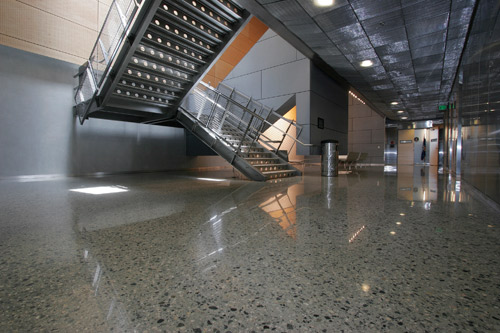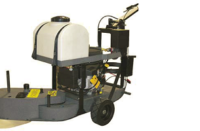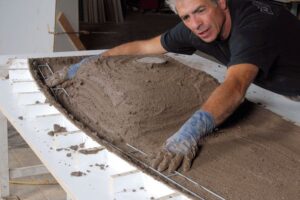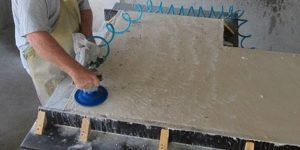
Does size matter in the world of polished concrete? I have heard the arguments on both sides for why smaller or larger polishing machines are better, but ultimately it depends.
There are jobs where a small lightweight machine would be out of the question due to the scope of work or the slab condition, and there are some jobs where it would be ridiculous to lug a thousand-pound machine onto the floor. The tool should fit the scope.
That makes buying decisions for newbie polishers a bit complicated. Different machines have different weights. How does a buyer decide which weight to go with when making that expensive leap into polishing-machine ownership?
Let’s look at some specific projects as examples.
First, consider the 250,000-square-foot floor of a manufacturing plant that was installed in the late 1970s. Covered and re-covered with various types of industrial coatings, it is under contract to be ground and polished. The contractor has 17 days of shutdown to completely remove the coatings, densify the floor and polish it up to a 3,000-grit finish, followed by the proper application of sealer and a final burnish step.
On a project of this size and scope, some lighter-duty machines can be used in supporting roles or processes that can assist in the speed of production. However, due to the amount of solid material at the surface that needs to be removed, larger and heavier-duty pieces of equipment are not optional.
Example two: A high-rise government administration building calls for a large-aggregate finish in all of the commons areas, which add up to approximately 60,000 square feet. The scope includes aggressive removal of 1/4 inch of concrete from the surface to expose the accurate size and density of aggregate envisioned and specified by the design team.
Again, the larger-platform heavy-duty pieces of equipment coupled with “super shavers” are the only realistic option to perform the demolition and preparation necessary to achieve the desired outcome. In these situations, all of the grinding and polishing processes could be performed using the heavy-duty machine, including the burnish step, thanks to the technology available now for this machine class.
Other situations favor smaller-platform lighter-duty machines. Let’s consider a residential project. A 1,800-square-foot project in a 4,200-square-foot home is requiring a lightly ground and polished and dyed concrete floor, with no coating or mastic removal, in four different locations within the residence. These locations are located on the main and basement levels. There is no ground-level access to the basement. This means that the machines that will be used will have to be carried (probably by hand) down the stairs and be capable of passing through interior doorways.
A high-speed light-duty polishing machine or a heavy-duty small grinder and polisher will be a much better fit for this project than a large-platform piece of equipment. With quality products and a knowledgeable craftsman, either of these types of equipment will be able to open the surface of the slab and prepare for dye as well as close the surface of the slab and polish to a high gloss.
In some larger-scale situations with concrete slabs that are in relatively good condition and require no coarse grinding for aggregate exposure or removing surface material, we find that both large and small types of equipment can produce a highly polished concrete surface.
In a situation where the slab needs only a light abrasion of the surface to open the pores to receive dye or densifier and then to close those pores with progressive light high-speed polishing steps, an entire project can be effectively completed using small-platform light-duty machines. However, while there are polishing projects like this in the market, a contractor who exclusively uses light equipment is limited to bidding only these perfect scenarios.
In a nutshell, when it comes to the optimal weight of the grinder-polisher you are about to purchase, the answer has everything to do with what type of projects you are interested in being capable of performing.
Down force
There are machines made mainly for prep that weigh more than 1,700 pounds. And there are machines made mainly for polishing that weigh less than 250 pounds. Both of these types of machines will represent themselves as grinder-polishers.
In general the larger machine is the more effective grinding tool, whereas in polishing the smaller machines can definitely hold their own. Why is it possible for the smaller machines to hone and polish the surface of the concrete so effectively but not be as effective grinding down into the surface?
In short, the grinding process requires “down force” while the polishing and honing process does not need as much.
If I am digging in the garden with a shovel and my 3-year-old son is digging beside me, we can use similar tools and perform similar steps but yield much different production rates. The size of my shovel and the down force I am able to apply to the surface allows for a much increased production rate. The same laws of physics apply using diamond grinding.
There are a few factors that can limit the effectiveness of added down force, such as the hardness of the slab and heat’s effects on the diamond segments. These will limit the effectiveness of increasing weight beyond a certain point by affecting the hardness of the tool face in contact with the surface. This is where added weight meets the point of diminishing return.
This effect can be offset by adding large amounts of water to the floor while grinding, to cool and lubricate the tools. This process makes a mess that adds significant time to the cleanup process, but it can break through the problems caused by heat and allow the added machine weight to increase the production of the diamond tools.
The grinding process requires a certain amount of pounds per square inch on the contact point to effectively drive the diamond mesh protruding from the tool face into the surface and be effective in removing stock.
Polishing and honing steps do not require all that head weight. These steps use speed instead of weight to close the surface.
I’d start big
In summary, it is my opinion that while light-duty polishing equipment definitely has its place in the market, I would not recommend that a contractor looking at starting a full-time business in this industry start with that type of equipment.
A light-duty machine may make a great second machine to follow the larger unit with fast-speed polishing steps or to polish those slabs that do not need any grinding or grouting. However, I would recommend that the contractor first buy a good heavy-duty piece of equipment that is designed for grinding and polishing. Learn the capabilities of that machine and the technologies available to that machine. This choice ensures that no matter what the concrete slab may need by way of prep or repair, the contractor is prepared and has the tool for the job.
In my previous business, we owned and used many light and heavy-duty units over 15 years of grinding and polishing production. We found certain jobs that were a perfect fit for the light-duty equipment, and we were glad to have a fleet of them when those projects came up. We also found many projects where it was good to have one or two of the light-duty machines to follow the larger units and thus increase production. But day-to-day production in that company to this day is performed using crews built around the number of heavy-duty grinders and polishers allotted to that team.
I also find this to be true with most of the larger polishing contractors that my current company supplies with grinding polishing equipment, chemicals and tooling today.
While light-duty polishing equipment has a great role in the grinding and polishing industry it does not yet appear to be ready to take the mantle from the large heavy-duty grinders and polishers in the market. While resourceful people and products are always improving the capabilities of both of these machine classes, I do not see a replacement for the large heavy-duty grinder and polisher as the main production tool in the near future.
















